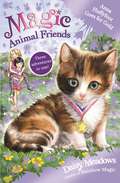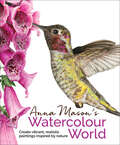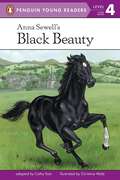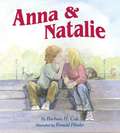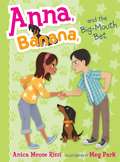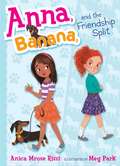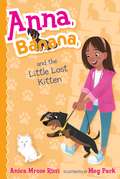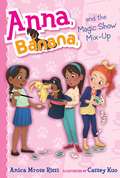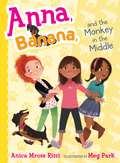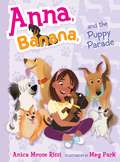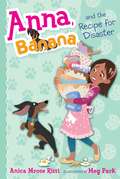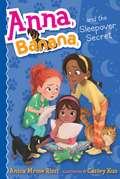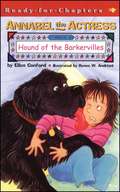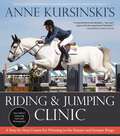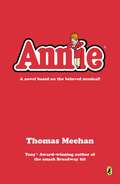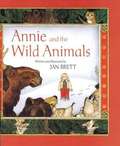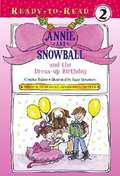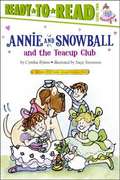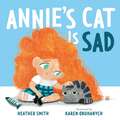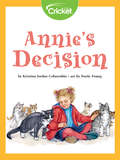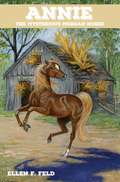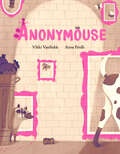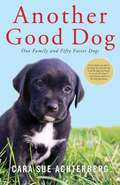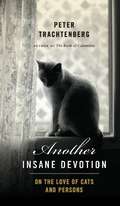- Table View
- List View
Anna Fluffyfoot Goes for Gold: Special 6 (Magic Animal Friends #6)
by Daisy MeadowsAn enchanting series full of adorable animals, magic and friendship - from the creator of RAINBOW MAGIC, the UK's bestselling series for girls aged 5-7.In the magical land of Friendship Forest, the animals are getting ready for a sports day! But wicked Grizelda wants to spoil everyone's fun. Can best friends Lily and Jess help super-cute kitten Anna Fluffyfoot stop the witch's horrible plans, before the special day is ruined?
Anna Mason's Watercolour World: Create Vibrant, Realistic Paintings Inspired by Nature
by Anna MasonLearn to find inspiration, plan your approach, and create stunning watercolour paintings inspired by the natural world.Anna’s vibrant, detailed and uplifting watercolours have earned her worldwide recognition. In this, her second book, she goes beyond flowers to explore her inspirations from across the natural world, including fruit, birds and animals. The book gives you a very personal insight into Anna’s way of working; with clarity and warmth she will help you find inspiration, choose scale and composition, see things correctly and work with discipline and flow until you produce fabulous work of your own. Packed with advice and inspiring finished pieces, this gorgeous book guides the reader through Anna’s method of working with a variety of beautiful step-by-step projects and exercises. It is suitable for beginners or for more experienced artists looking to refine their style or try some new techniques.“This book is glorious in every sense, from the beautiful cover to the absolutely stunning paintings throughout the book, this is something to bring joy on the dullest of days. . . . This beautiful book is packed full of helpful advice, how to garden, how to photograph, and how to paint from those photographs, how to understand colour, form and texture.” —My Creative Notebook“This engaging guide to painting a wide variety of natural subjects is packed with information and inspiration. . . . This is an intriguing, enthralling and thoroughly enjoyable book.” —The SAA Catalogue
Anna Sewell's Black Beauty (Penguin Young Readers, Level 4)
by Cathy EastBlack Beauty, published in 1877 and set in Victorian London, was Anna Sewell?s only novel. Yet it has remained a classic for 140 years. Now the beloved story of Black Beauty is retold for beginning readers with full-color illustrations on every page.
Anna and Natalie
by Barbara H. ColeAnna is never picked to be on any team at school. But she is determined to be chosen when Mrs. Randall announces a letter-writing contest to decide which four students will be part of the wreath-laying team at the Tomb of the Unknown Soldier in Arlington, Virginia. This moving story of how Anna deals with her disability will touch the hearts of all readers as they cheer her on to the surprise ending.
Anna, Banana, and the Big-Mouth Bet: Anna, Banana, And The Friendship Split; Anna, Banana, And The Monkey In The Middle; Anna, Banana, And The Big-mouth Bet; Anna, Banana, And The Puppy Parade (Anna, Banana #3)
by Anica Mrose RissiAnna finds herself standing up to the class clown in the third book of a charming illustrated chapter book series about the joys and challenges of elementary school friendships.Anna has a loose tooth! It’s as wiggly as her dog Banana’s tail. But when Anna is poking at her loose tooth, class clown Justin keeps poking fun at Anna and her friends. Anna tries to make Justin leave them alone and gets pulled into a high-stakes bet. If Anna wins, Justin has to play nice; but if Anna loses, she has to do something so jaw-droppingly embarrassing, even Banana can’t believe it. There’s no wiggling her way out of this one. Anna has to win this bet.
Anna, Banana, and the Friendship Split: Anna, Banana, And The Friendship Split; Anna, Banana, And The Monkey In The Middle; Anna, Banana, And The Big-mouth Bet; Anna, Banana, And The Puppy Parade (Anna, Banana #1)
by Meg Park Anica Mrose RissiMeet Anna and her beloved wiener dog, Banana, in this start to a charming illustrated chapter book series about the joys and challenges of elementary school friendships.Anna has been best friends with Sadie for as long as she can remember. So Anna is utterly perplexed when, on Anna's birthday, Sadie unceremoniously stakes claim to Anna's new pony necklace, then suddenly stops speaking to Anna altogether. Did Anna do something wrong? With a little help from her wiener dog, Banana, as well as some sage advice from her family, Anna makes some important discoveries about what it means to stand up for herself, and how to be a true friend.
Anna, Banana, and the Little Lost Kitten (Anna, Banana #5)
by Meg Park Anica Mrose RissiAnna and Banana rescue a stray kitten in the fifth book of this “fast-paced, fun, and funny” (Megan McDonald, bestselling author of the Judy Moody series) illustrated chapter book series about the joys and challenges of elementary school friendships.Anna and Banana have found a kitten! But when Banana accidentally scares the kitten away during their afternoon walk, Anna enlists her two best friends, Sadie and Isabel, for OPERATION CATCH THE KITTEN. Anna can’t image such a tiny kitten living outside all by himself, and she’s determined to find him a good home. But catching a kitten is trickier than Anna thought—kittens are easily scared and very stealthy. Then there’s the problem of finding him a good home. Sadie’s mom has a “No Pets” rule, Isabel’s cat, Mewsic, does not play well with other animals, and Anna’s dad is allergic to cats! Anna and her friends desperately want to help, but will they be able to find the kitten a good home?
Anna, Banana, and the Magic Show Mix-Up (Anna, Banana #8)
by Anica Mrose RissiWhen preparing for a magic show, Anna and her friends find a talent for trouble instead in the eighth book of this &“fast-paced, fun, and funny&” (Megan McDonald, bestselling author of the Judy Moody series) illustrated chapter book series about the joys and challenges of elementary school friendships.Anna, Sadie, and Isabel develop an interest in magic tricks when their frenemy Justin mystifies them with a cool card trick but refuses to tell them how he did it. Determined to figure it out for themselves, the girls set out for the best place to find answers—the library!—ready to learn every magic trick in the book. But magic isn&’t as easy as it appears, even with a book of instructions. When Anna goes to her neighbor Mrs. Shirley for advice, she finds out that while Mrs. S doesn&’t know any magic tricks herself, her very favorite birthday party ever was a magician show where the magician pulled a rabbit out of a hat. With the neighborhood potluck coinciding with Mrs. Shirley&’s seventy-sixth birthday, Anna and her friends decide to practice their own magic act to perform for her, but a whole slew of mix-ups ensue as they try to puzzle out how the tricks are done and how to figure out Justin&’s secret, too. Can Anna and her friends perform some magic and get the mix-ups under control before—presto—it&’s showtime?
Anna, Banana, and the Monkey in the Middle: Anna, Banana, And The Friendship Split; Anna, Banana, And The Monkey In The Middle; Anna, Banana, And The Big-mouth Bet; Anna, Banana, And The Puppy Parade (Anna, Banana #2)
by Meg Park Anica Mrose RissiAnna finds herself torn between two friends in the second book of a charming illustrated chapter book series about the joys and challenges of elementary school friendships.Sadie and Isabel are Anna's two best friends, and Anna can't wait to go with them on the class field trip to the zoo--but she keeps getting caught in the middle. Isabel wants Anna to see the tortoise with her, but Sadie wants to see the spiny anteater. Isabel wants to do their group report on giant pandas, while Sadie wants them to write about zebras. With a little help from her beloved dog, Banana, as well as some wise advice from her family, can Anna figure out what it means to be a best friend to two very different people--and still be a friend to herself?
Anna, Banana, and the Puppy Parade: Anna, Banana, And The Friendship Split; Anna, Banana, And The Monkey In The Middle; Anna, Banana, And The Big-mouth Bet; Anna, Banana, And The Puppy Parade (Anna, Banana #4)
by Anica Mrose RissiAnna enters her beloved dog Banana in a contest in the fourth book of this “fast-paced, fun, and funny” (Megan McDonald, bestselling author of the Judy Moody series) illustrated chapter book series about the joys and challenges of elementary school friendships.Anna can’t wait for the Puppy Parade. She’s certain Banana will win. Soon Banana will be famous—and that means Anna will be famous, too! But when Sadie and Isabel suggest they all enter the parade together, Anna starts feeling a little unsure about sharing her dog—and the spotlight—with her friends. How can Anna be Best in Show and a good best friend?
Anna, Banana, and the Recipe for Disaster (Anna, Banana #6)
by Meg Park Anica Mrose RissiAnna and Banana must cook up a solution when her jealousy gets her into some hot water in the sixth book of this “fast-paced, fun, and funny” (Megan McDonald, bestselling author of the Judy Moody series) illustrated chapter book series about the joys and challenges of elementary school friendships.After watching the contestants on The Batter-Up Bake-Off Show whip up sweet treats, Anna, Isabel, Sadie, and Banana are ready to put their culinary chops to the test. The plan? To make the best-ever cookie recipe for the town library’s bake sale! There’s only one problem: Isabel and Sadie have started hanging out with a girl named Monica, and suddenly she’s all they can talk about. Anna’s sure she, Sadie, and Isabel are complete as a trio, and winning the bake sale will prove it. But when Monica shows up with Sadie and Isabel for their big baking day things quickly turn from sweet to sour. Can Anna win back the attention of her two besties, or will she learn that friendship—like cookies—is best when shared?
Anna, Banana, and the Sleepover Secret (Anna, Banana #7)
by Anica Mrose Rissi Cassey KuoAnna wrestles with a big secret at Isabel’s super-fun sleepover in the seventh book of this “fast-paced, fun, and funny” (Megan McDonald, bestselling author of the Judy Moody series) illustrated chapter book series about the joys and challenges of elementary school friendships.Anna and her friends love having sleepovers. So, when Isabel invites Anna and Sadie to spend the night at her house for the first time Anna can’t wait! Between pranking Isabel’s older sisters, make-your-own pizzas, and truth or dare this is going to be the best night ever. But when one of Isabel’s older sisters’ dares results in Anna breaking a really special vase, everything stops being all fun and games. Isabel’s sisters convince the girls they can hide it from their parents, but after her friends fall asleep, Anna lies on the floor in her sleeping bag, wide awake. At night, with the lights out and everyone else sleeping, Isabel’s house seems different. Unfamiliar. Not like home. Anna misses Banana terribly, and worst of all she feels really guilty keeping what happened a secret. If Anna doesn’t stay at the sleepover, everyone might get mad at her for ruining it, but if she stays and lets the secret slip about the broken vase, everyone might get mad at her for that instead. Anna and her friends share all their secrets, but can they help her with her secret dilemma?
Annabel the Actress, Starring in the Hound of the Barkervilles
by Ellen ConfordWhen Annabel, who wants to be a famous actress someday, has a part in a real play, she finds she must cope with a big dog and an unruly audience member.
Anne Kursinski's Riding and Jumping Clinic: New Edition
by Anne KursinskiOlympic Show Jumper Anne Kursinski&’s acclaimed guide to riding horses over fences, now updated with hundreds of full-color photographs. Olympian Anne Kursinski&’s acclaimed book on riding horses over fences delivers on-target counsel and the kind of sophisticated, quality instruction you can only get in top barns around the world. Let this medal-winning international competitor show you &“how it&’s done&” with step-by-step descriptions of dozens of exercises to improve your position, your &“feel,&” and your overall understanding of how to confidently and successfully master a jump course. Inside, you&’ll find a top-notch education in both basic and advanced flatwork and jumping, including: Bending Adjusting stride length Moving laterally Riding straight lines and curves Jumping without stirrups Flying changes Flexion and collection Counter-canter Half-pass Ways to perfect distances and count strides Tips for riding different kinds of combinations, bigger jumps, and natural fences. Throughout, Kursinski&’s explanations are clarified with hundreds of illuminating photographs, completely reshot in full color for this new edition. Even better, the photos feature Kursinski herself in the saddle, and the text includes her illuminating personal commentary describing what she is experiencing in the saddle during a particular exercise. In addition, this revised edition includes an all-new chapter on riding derby-style courses as well as course walks with Kursinski, to give readers a sense of how she plans a winning ride. This classic references offers time-tested techniques and invaluable skills for every hunter, jumper, and equitation rider.
Annie
by Thomas MeehanIt's a hard-knock life for America's favorite orphan! Everyone knows the story of the irrepressible Annie, who lives at Miss Hannigan's orphanage until she beats the odds and finds a new life with the benevolent and wealthy Daddy Warbucks. Annie has enchanted millions of readers from her original comic strip appearance to the hit Broadway musical. Now, with a Tony-nominated revival playing on Broadway, Puffin is reissuing this novelization of the classic story, with a new introduction by Tony and Emmy Award-winning author Thomas Meehan. This is an adaptation that delves even deeper into Annie's story, as she lives on the streets during the Great Depression, finds Sandy the dog, and encounters characters both familiar and new.
Annie And The Wild Animals
by Jan BrettWhen Annie's cat disappears, she attempts friendship with a variety of unsuitable woodland animals. The borders of the pages foretell the emergence of spring and the birth of kittens.
Annie and Snowball and the Dress-up Birthday
by Cynthia RylantAnnie and her pet bunny, Snowball, love living next door to Annie's favorite cousin, Henry and his dog, Mudge. Whether it's playing Frisbee or watching old movies, there's no shortage of fun to be had when these four are together. Annie's birthday is coming up, and she can't wait to invite Henry and Mudge over for a dress-up party. But when the guests arrive, it's Annie who gets the big surprise! Picture descriptions present.
Annie and Snowball and the Teacup Club
by Cynthia RylantAnnie loves teacups. She loves their pretty shapes. She loves their painted flowers. She loves their dainty little saucers. Her cousin and best friend, Henry, doesn't love teacups. Henry isn't interested in dainty things. Henry's dog, Mudge, weighs almost two hundred pounds, which is definitely not dainty!Can Henry help Annie find friends who love teacups as much as she does?
Annie's Cat Is Sad
by Heather SmithA little girl navigates her cat's bad day in this picture book about exploring sadness and how we find comfort.Annie comes home from school to find her cat, Delilah, has had a terrible day and is quite sad.What do you do when your friend is sad? Cheer them up with all the things they love! Annie tries TV, warm milk, and even yoga! But at the end of the day, no distraction can really make our bad days simply disappear, as Annie knows all too well. You just have to face them head-on, maybe have a good cry, and find comfort inthose you love. Heather Smith has written a gentle picture book about how we sometimes have to sit in the sadness of a bad day before we can move beyond it. Paired with Karen Obuhanych's bold, emotive illustrations, readers will feel seen by Annie's Cat Is Sad.
Annie's Decision
by Kristina Jordan CobarrubiaIn this heartwarming story of acceptance, a young blind girl named Annie has a difficult decision to make. Should she adopt a cuddly baby kitten, as most people want to do? Or should she adopt the older cat who adopts her first?
Annie: Sandy's Story
by Ashley FedorInspired by the hit Broadway musical, AnnieWe all know the story of Little Orphan Annie, who is down on her luck during the Depression until she finds her beloved dog Sandy and her benevolent benefactor Daddy Warbucks. <P><P>Now the story is told for a younger audience through the eyes of Sandy, providing another perspective and a deeper look into the life of the famous canine character. After being abandoned by his own family, Sandy roams the streets, living his own hard-knock life, until he finds one irrepressible little redhead who will change his life forever. Includes black-and-white illustrations.
Annie: The Mysterious Morgan Horse (Morgan Horse Series #5)
by Ellen F. FeldAnnie introduces a new horse to the award-winning Morgan Horse series. Uncertain of the mare's origin, Chauncy decides to bring Annie home to Gallant Morgans, but he makes it clear she can only stay if he can locate her registration papers. When Heather discovers Annie's true identity, she is afraid to tell Chauncy, knowing the horse may be returned to a cruel trainer. Heather hides the truth from her friend and soon events spiral out of control.
Anonymouse
by Vikki VanSickleAnimal-friendly street art is popping up all over the city, but who is creating these masterpieces? There is no explanation, only a name: Anonymouse. For fans of Sidewalk Flowers and Art & Max.Art for the birds. Art for the ants. Art for the dogs, cats and raccoons. Art to make them laugh, make them think, make them feel at home. But who is creating it? Only Anonymouse knows for sure . . .This clever tale mixes street art, animals and gorgeous illustrations to create a meditation on how art can uplift any creature's spirit -- human or animal -- when it speaks directly to them. Every page of Anna Pirolli's stunning artwork is its own masterpiece with its bold pops of colour and sly humor, elevating Vikki VanSickle's subtle but evocative text.
Another Good Dog: One Family And Fifty Foster Dogs
by Cara Sue AchterbergA warm and entertaining memoir about what happens when you foster fifty dogs in less than two years—and how the dogs save you as much as you save them. When Cara felt her teenaged children slipping away and saw an empty nest on the horizon, she decided the best way to fill that void was with dogs—lots of them—and so her foster journey began. In 2015, her Pennsylvania farm became a haven for Operation Paws for Homes. There were the nine puppies at once, which arrived with less than a day’s notice; a heart- worm positive dog; a deeply traumatized stray pup from Iraq; and countless others who just needed a gentle touch and a warm place to sleep. Operation Paws for Homes rescues dogs from high-kill shelters in the rural south and shuttles them north to foster homes like Cara’s on the way to their forever homes. What started as a search for a good dog, led to an epiphany that there wasn’t just one that could ll the hole left in her heart from her children gaining independence—she could save dozens along the way. The stories of these remarkable dogs— including an eighty-pound bloodhound who sang arias for the neighbors—and the joy they bring to Cara and her family (along with a few chewed sofa cushions) fill the pages of this touching and inspiring new book that reveals the wonderful rewards of fostering. When asked how she can possibly say goodbye to that many loveable pups, Cara says, “If I don’t give this one away, I can’t possibly save another.” Filled with humanity and hope, Another Good Dog will take the reader on an journey of smiles, laughs, and tears—and lead us to wonder how many other good dogs are out there and what we can do to help.
Another Insane Devotion: On the Love of Cats and Persons
by Peter TrachtenbergAn exploration of the mysteries of love and marriage, pleasure and obligationOCothrough the lens of cat ownership"
